When I first saw photos of Tulum, I thought: “Okay, someone definitely overdid it with the filters…” Mayan ruins suspended above a turquoise sea, cenotes like something from another world, beaches white as flour.
But here’s the thing – Instagram has this thing where it only shows the best shots. And I want to show you the whole truth.
I spent eight days in Tulum – long enough to experience the magic of this place, but also to see things nobody talks about. Seaweed on the beaches. Prices that knock you off your feet. The crowds at 10 AM.
So… is Tulum worth visiting in 2026? Yes – and no. Let me explain.
In this honest Tulum travel guide, I’ll walk you through the 10 best things to do in Tulum, plus what you can safely skip. I’ll share my honest opinions, favorite places, prices, and concrete tips – no filter.
In this honest Tulum travel guide, I’ll walk you through the 10 best things to do in Tulum, plus what you can safely skip.
Let’s dive into my very real Tulum experience – the good, the disappointing, and everything in between.
Planning a trip to the Yucatan? Check out my full Mexico travel guide – it’s packed with extra tips, routes, and soulful places that will help you plan your journey even better.

1. Mayan Ruins – A View Worth Waking Up at 7 AM For
There are places you’ve seen a million times in photos, and they still take your breath away when you stand in front of them.
The Mayan ruins in Tulum are exactly one of those places.
A 13th-century city, suspended on a cliff above the Caribbean Sea. Stone structures reflecting in turquoise water. Pelicans soaring above the El Castillo pyramid.
But – and this is an important “but” – you need to come early. Really early.
The first day I came at 10:00 AM. Big mistake.
Crowds of tourists. Heat like hell (zero shade!). I couldn’t take a photo without dozens of people in the frame. I felt like I was at Disneyland, not in an ancient Mayan city.
The next day I got up at 6:30 and was at the gate right at 8:00 (opening time). And it was a completely different experience.
Almost empty citadel. Fresh morning air. Silence interrupted only by the sound of waves. I could sit by El Castillo and just… be. Truly feel this place.
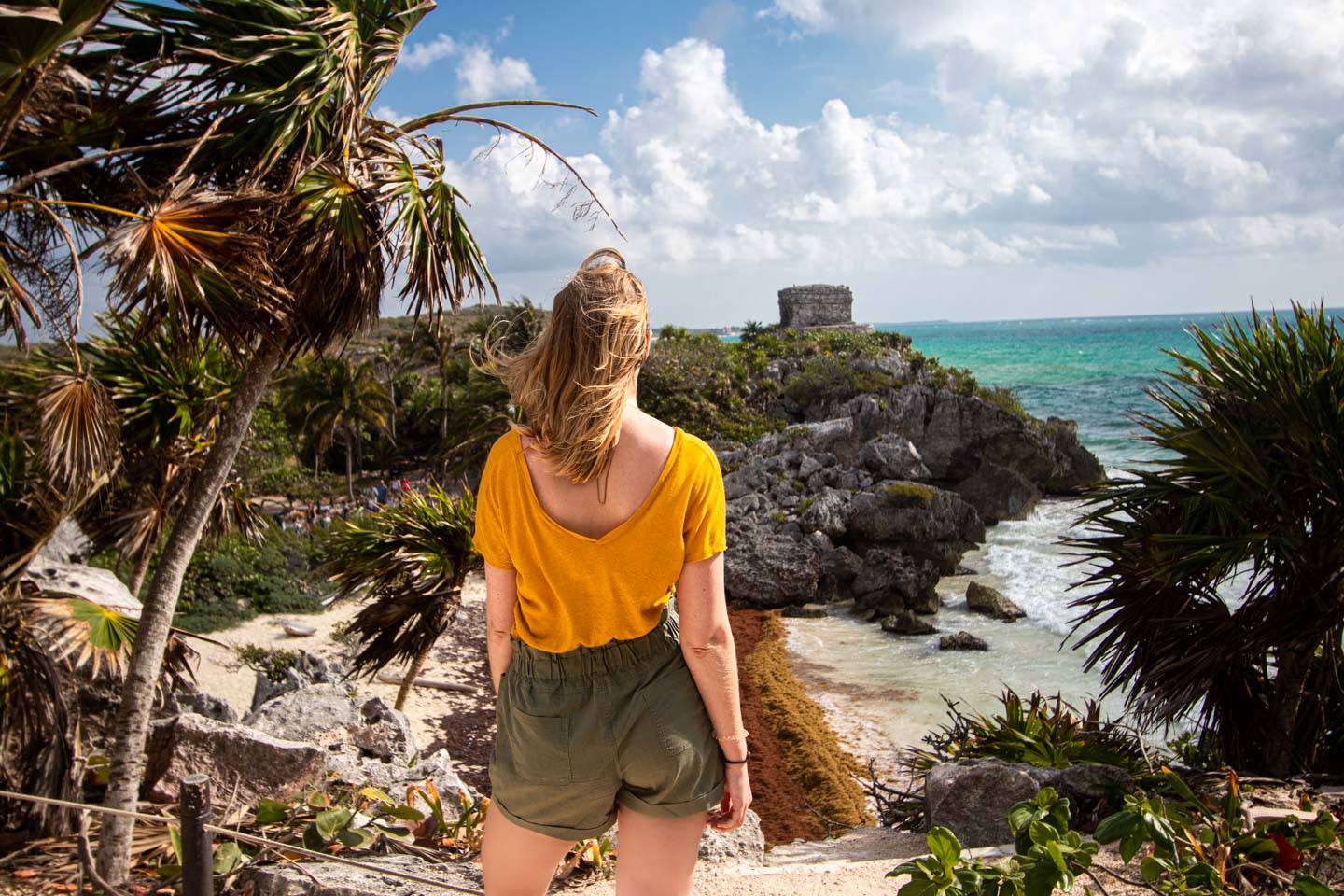
What You’ll See:
- El Castillo (main pyramid and former lighthouse)
- Templo del Dios Descendente (Temple of the Descending God)
- Templo de los Frescos (Temple of Frescoes)
- Small beach right below the ruins (you can swim!)
Practical Info:
- Open: 8 AM – 5 PM (be there right at 8!)
- Admission: 515 pesos (~$28 USD)
- Parking: around 150 pesos
- Visit time: 1.5-2 hours
- No shade – bring a hat, water, and sunscreen
My Honest Take:
Worth every penny and every minute. But only if you come early in the morning or late afternoon (after 3 PM). During the day it’s tourist hell.
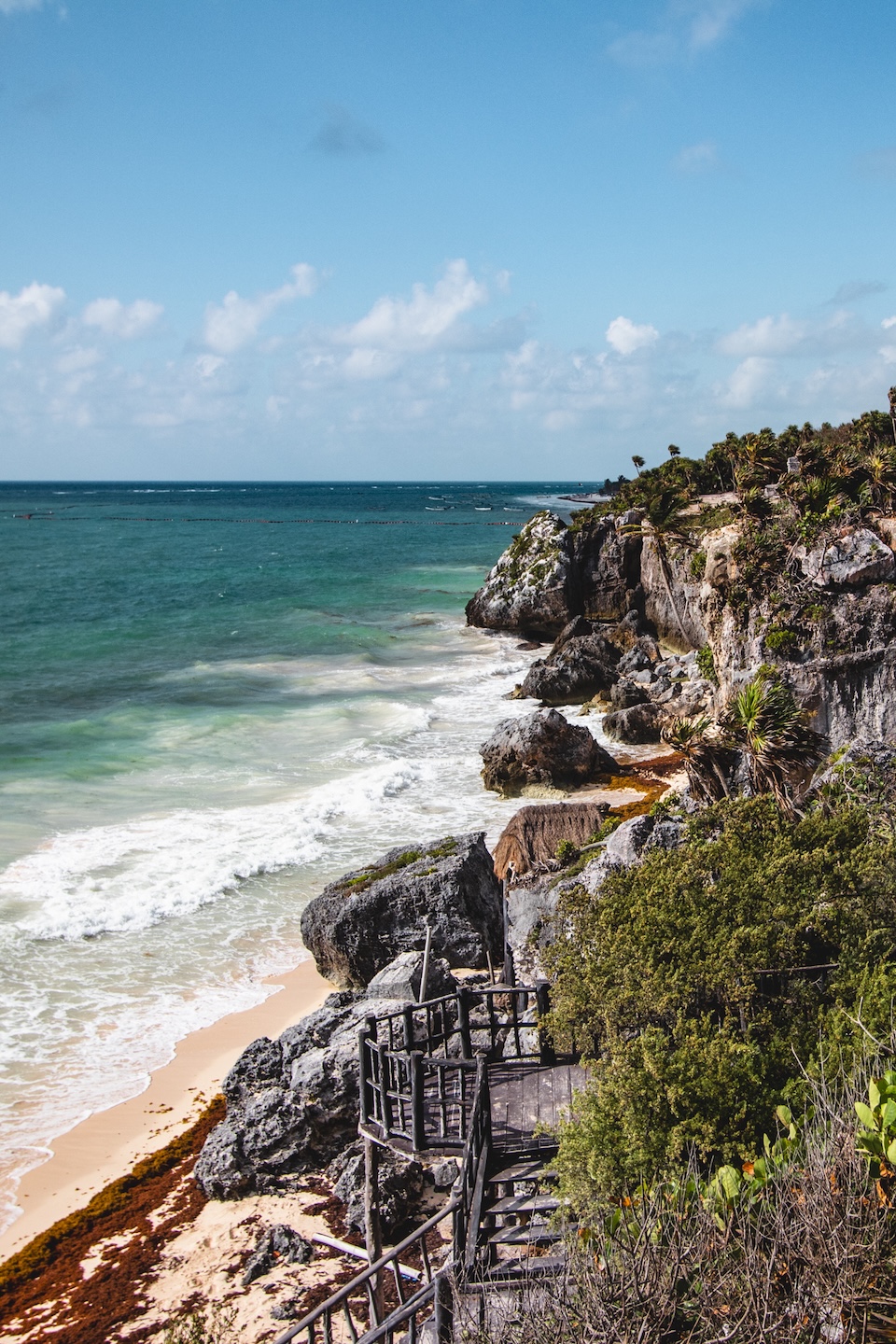
What About Other Ruins?
- Cobá (about 40 minutes from Tulum): I didn’t go myself, but many people say you can climb the pyramid. In Tulum you can’t – which disappointed me a bit.
- Chichén Itzá (2.5 hours): One of the seven new wonders of the world. Impressive? Yes. Worth five hours of driving? Depends how much time you have.
- Ek Balam (2 hours): I went – and highly recommend! Less touristy, wilder, with the ability to climb the main pyramid. If you want to see ruins without crowds and feel the spirit of ancient times – this is a bullseye.
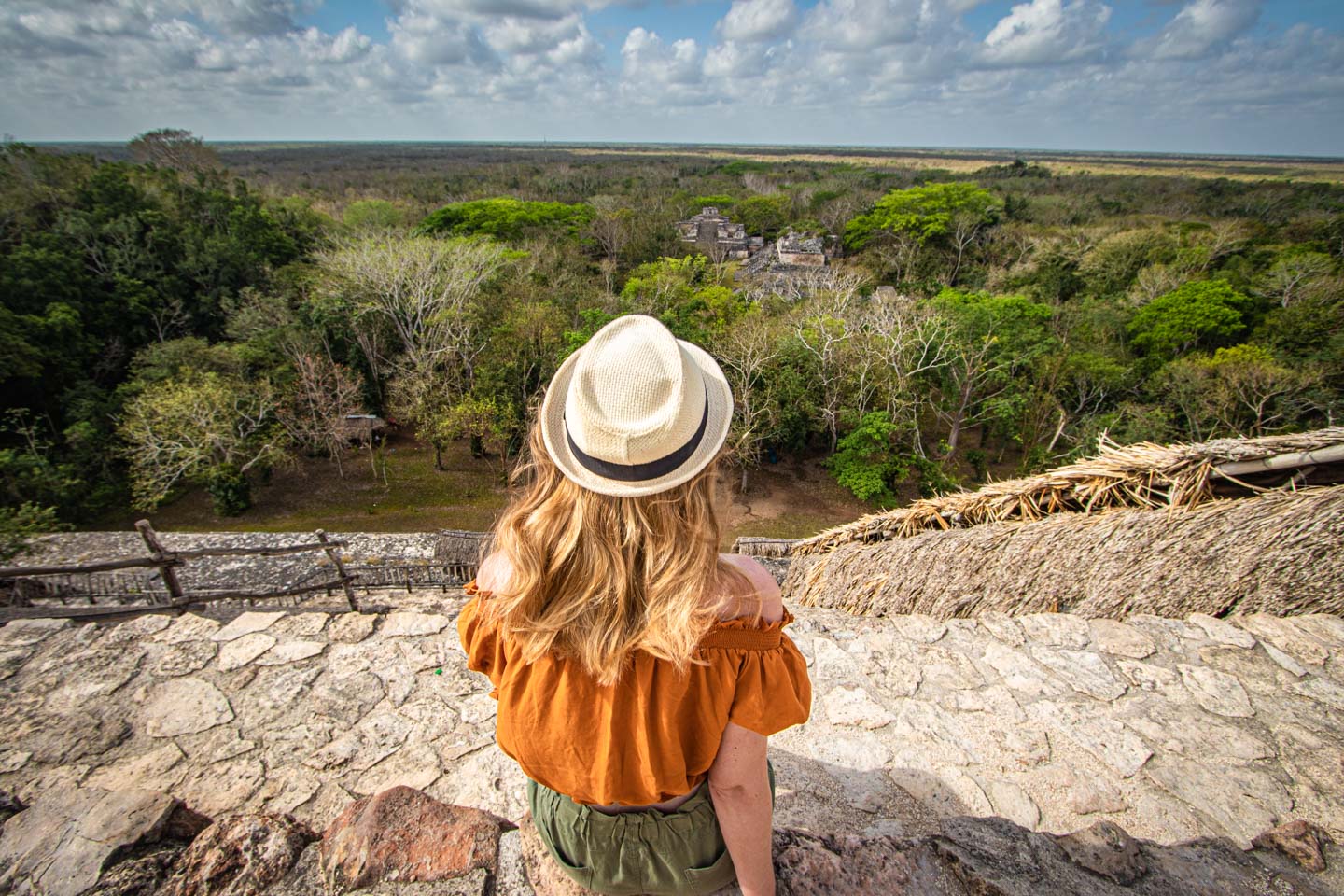
2. Cenotes – Where Swimming Becomes a Spiritual Experience
If you think a cenote is just “a pool in a cave” – prepare for a perspective change.
Cenotes are natural wells in limestone rocks, filled with crystal-clear water. For the Maya, they were sacred places – gateways to the underworld.
And when you immerse yourself in one… you really understand why.
Water so clear you can see the bottom ten meters down. Rays of sunlight breaking through holes in the rock. Silence, interrupted only by the echo of dripping water.
This isn’t ordinary swimming. This is an experience.
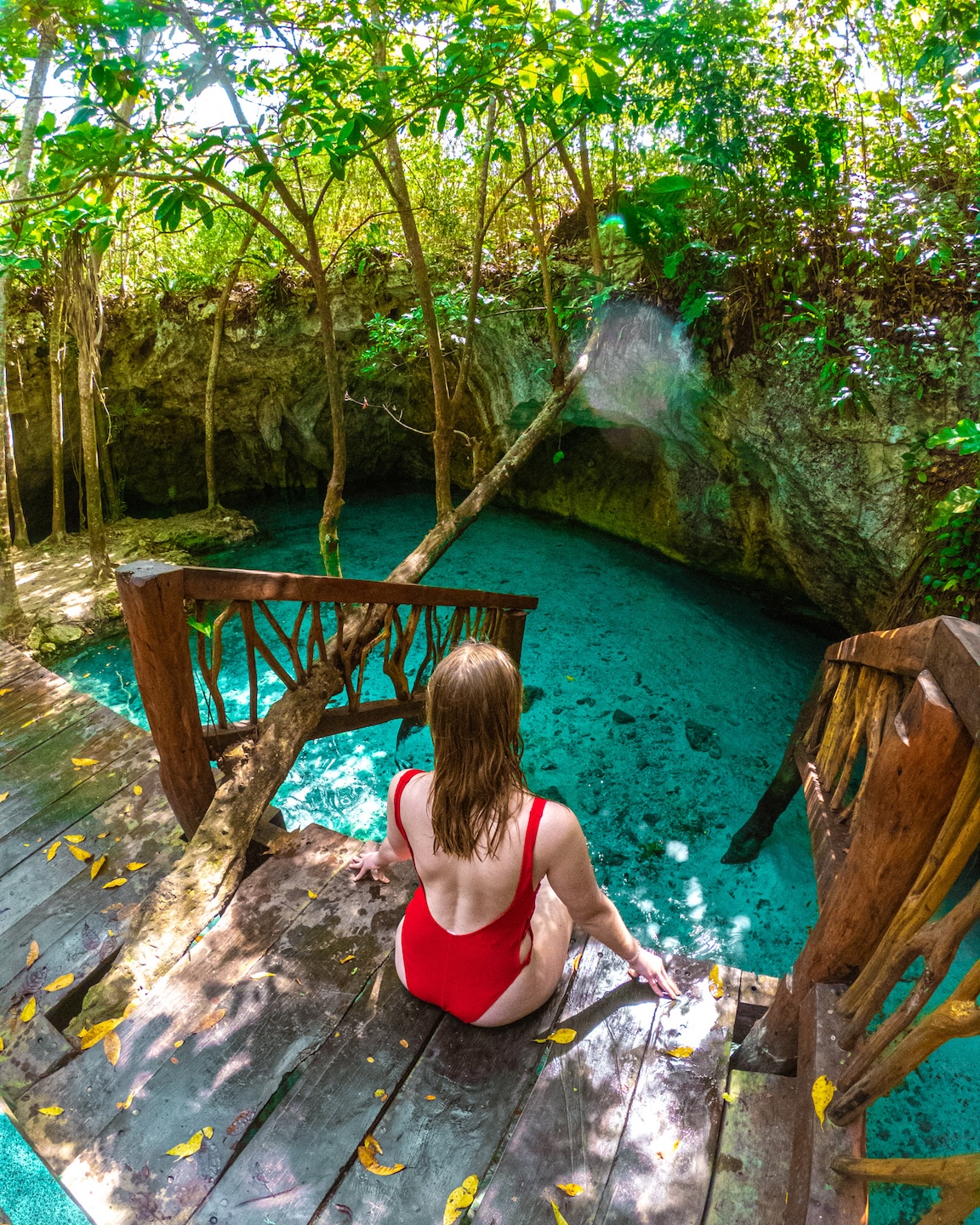
My top 3 cenotes (personally tested)
Gran Cenote – Most Popular (But Not Without Reason)
This was my first cenote. And I immediately understood all the excitement.
It’s a combination of an open cenote with underwater caves. Water so transparent it seems unreal. I saw three turtles, lots of small fish, and underwater stalactites that looked like something from another world.
But…
- Popular = crowded (I was there at 9:00 and there were already lots of people)
- More expensive than others: 500 pesos (~$25 USD)
- Mandatory shower before entry – no creams, oils, or perfumes
How I Did It: Come right at opening, around 8:10 AM, or after 3 PM. Midday gets crowded with organized tours.
What to Bring:
- Goggles or snorkeling mask (can rent on site for 100 pesos)
- Towel
- Cash (not everywhere accepts cards)
- Waterproof phone case
Practical info:
- Hours: 8:10-16:45 (last entry at 16:15)
- Admission: 500 pesos
- Parking: free
- Lockers: 50 pesos
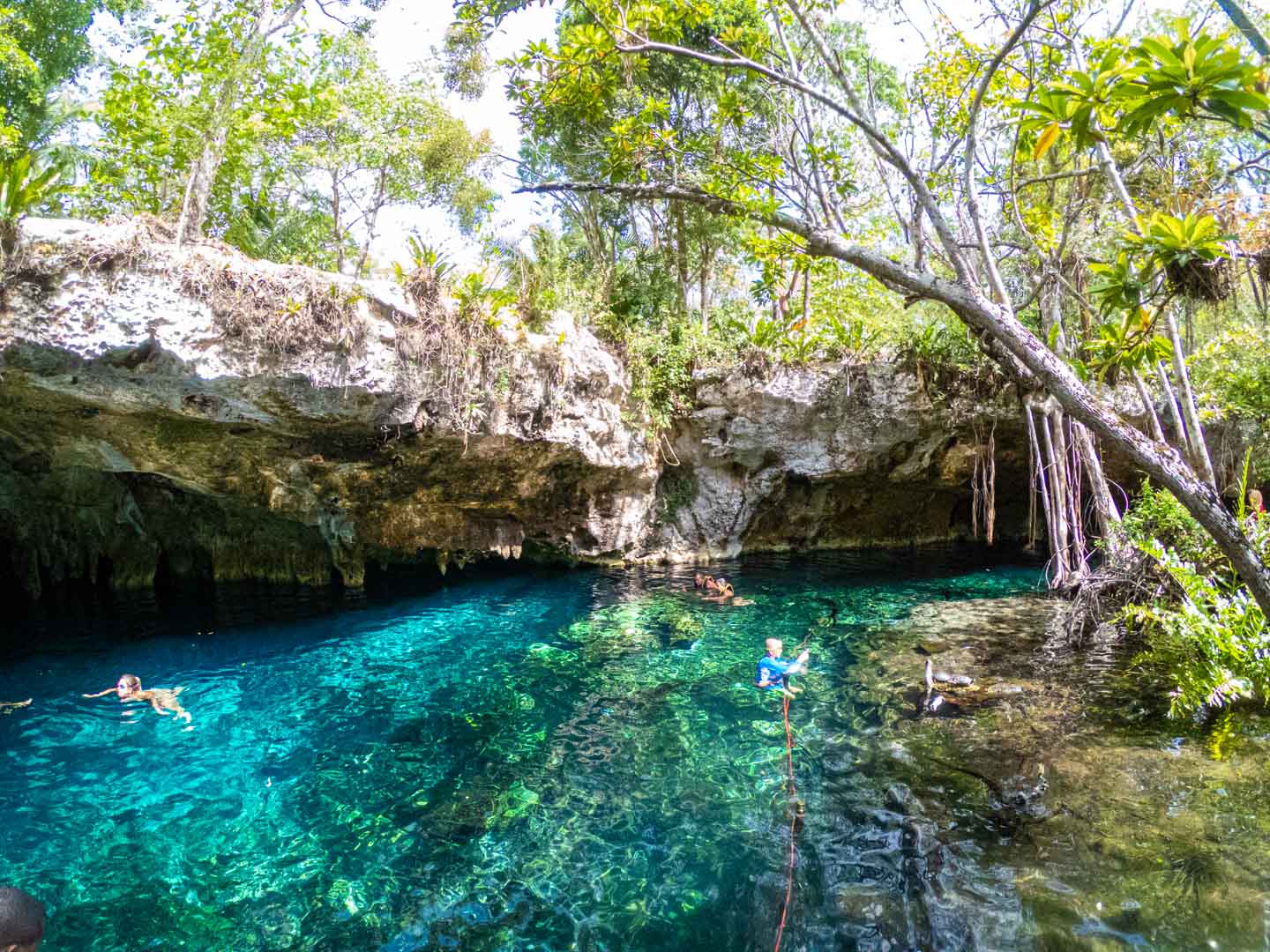
Dos Ojos – For Those Who Love Caves
Dos Ojos is actually two cenotes connected by a cave system (the name literally means “two eyes”). This place is wilder, more rugged, and definitely more adventurous than Gran Cenote.
Here you need a flashlight (can rent on site), because you swim in semi-darkness – and sometimes in complete darkness, where the only source of light is rays of sun falling through cracks in the rocks and your own flashlight.
This experience is more like cave exploration than bathing. And definitely not for everyone.
Who it’s for:
If you don’t have claustrophobia and love a bit of adventure thrill – this will be your place.
Practical Info:
- Open: 8 AM – 5 PM
- Admission: 400 pesos
- Fewer tourists than at Gran Cenote
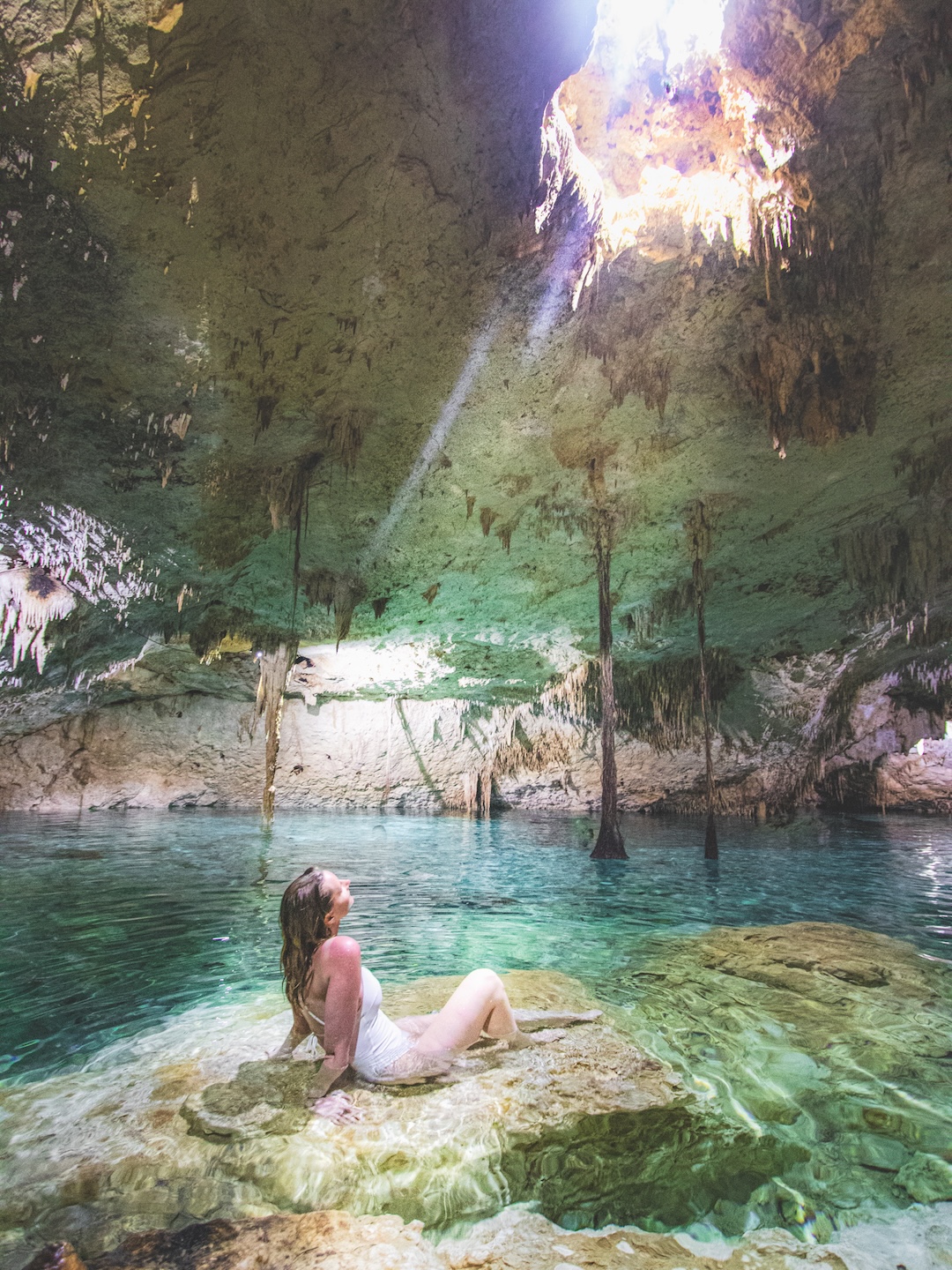
Cenote Taak Bi Ha – Hidden Gem (My Favorite)
This was my cenote surprise – and absolute favorite.
Smaller, less known, almost empty when I got there (around 11:00 AM midweek). And absolutely magical.
It’s an open cenote with shallow, calm water. Surrounded by jungle, with hammocks hanging over the water, in silence interrupted only by rustling leaves.
This isn’t a place for snorkeling or exploration. This is a place where you just… rest. Breathe. Are.
My Honest Take:
If you’re looking for peace, want to escape the crowds, and find your piece of paradise – this is it. Less spectacular than Dos Ojos, but much more relaxing than Gran Cenote.
Practical Info:
- Open: 9:30 AM – 5 PM
- Admission: 350 pesos
- Perfect for a peaceful afternoon after visiting ruins
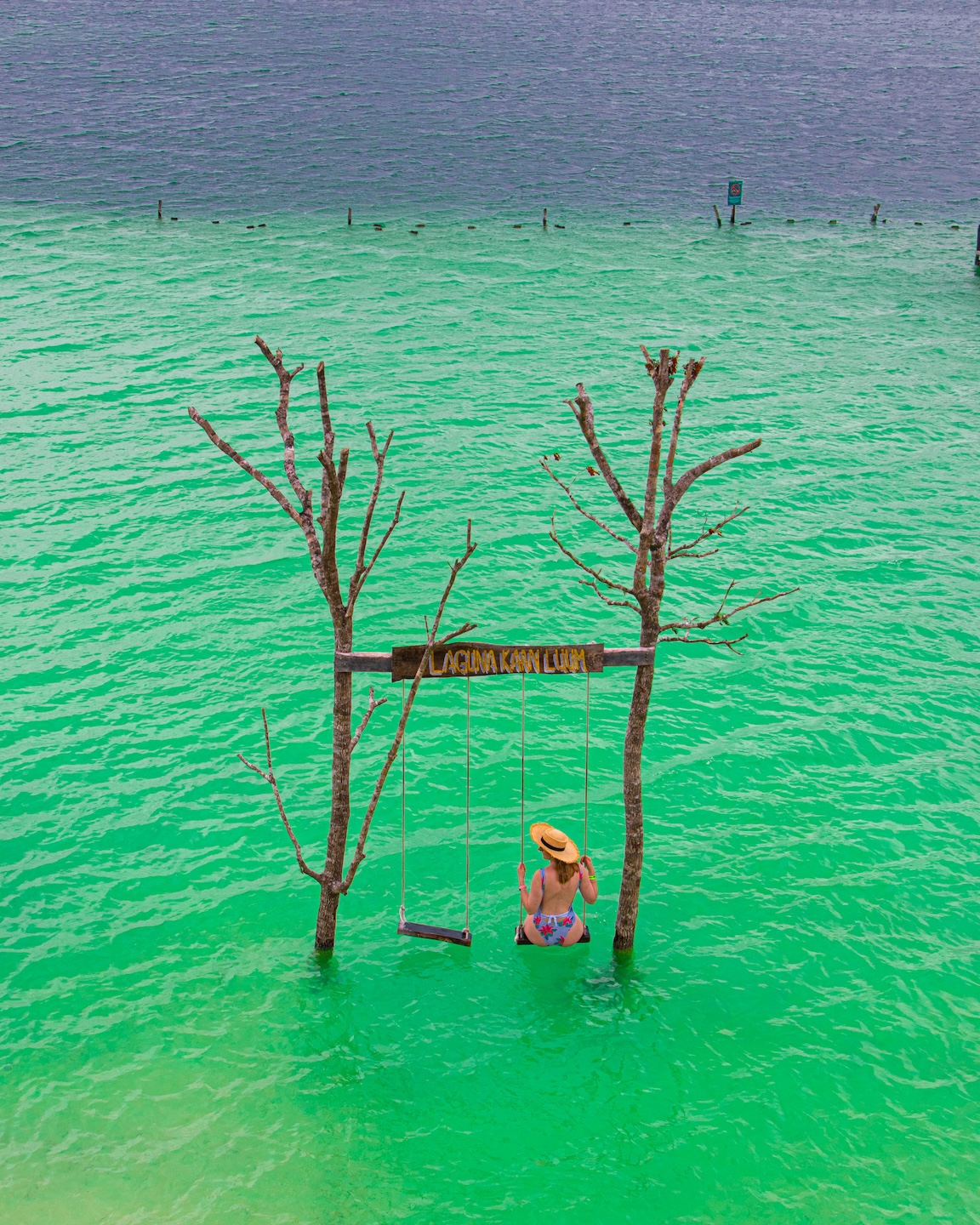
3. Kaan Luum Lagoon – Instagram vs Reality
“This looks too beautiful to be real” – I thought, scrolling through Instagram. And I was right. Though not in the way I expected.
I arrived on Saturday, around 11:00 AM. First mistake.
What I Saw:
- Line to get in (30 minutes waiting)
- Crowds of people at the pier (impossible to take a photo without 20 people)
- Loud music from a speaker, somewhere in the crowd
- Water full of swimming tourists
The water really was beautiful – shallow, warm, turquoise. Kids had a great time, the atmosphere was vacation-like. But if you dream of a peaceful, Instagrammable shot in solitude… forget it.
What Would the Wiser Version of Me Do?
- Come midweek
- At 9:00 AM, right at opening
- Stay maximum 2 hours (and that’s enough)
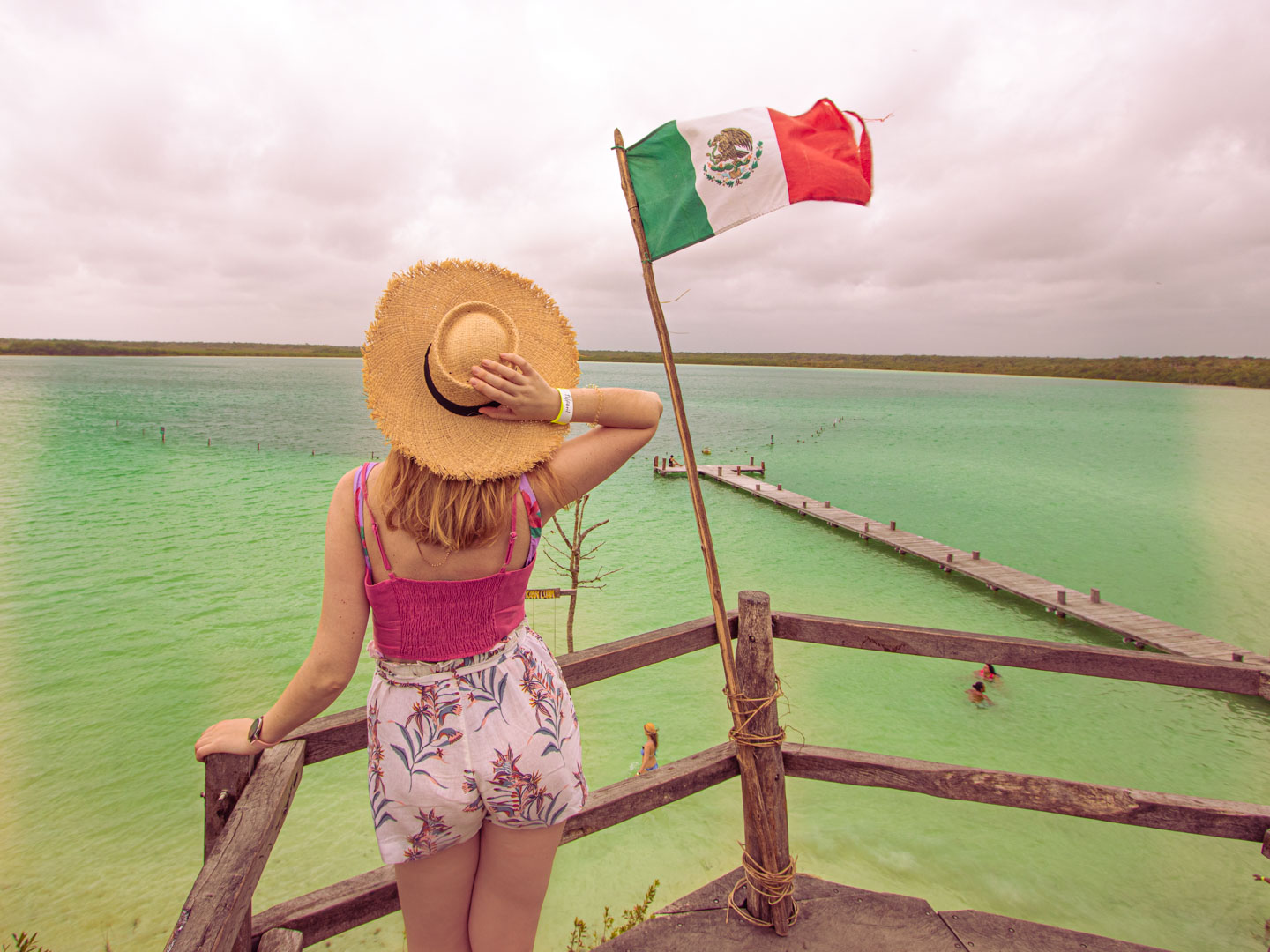
Practical Info:
- Opening hours: 9 AM – 5 PM
- Admission: 300 pesos
- Getting there: about 15 minutes by car from Tulum (worth having your own transportation)
- On site: hammocks, swings, piers
Who It’s For:
Families with children (shallow, safe water), drone photo fans, Instagrammers (if they come early), people who just want to bathe in a nice place.
Who It’s Not For:
If you’re looking for silence, breath, and a sense of intimacy with nature – choose cenote Taak Bi Ha instead.

4. Sunrise – Why I Got Up at 5:30 Every Day
I’m not an early bird. Really not. But in Tulum I made an exception. And I don’t regret a single early morning.
Why was it worth it?
Because the sun rises here directly over the Caribbean Sea. The sky changes colors from deep navy blue, through pink and orange, to gold and bright blue.
The beach is completely empty. You can only hear the waves. You can sit barefoot in the sand with a cup of coffee and just… watch.
This is the moment when Tulum stops being a tourist destination and becomes a spiritual place. Intimate. Yours.
My ritual:
- Alarm at 5:30 AM
- Coffee in a thermos
- Walk to the beach at 5:50 AM
- Sit and wait
- Sunrise around 6:15 – 6:30 AM (in April)
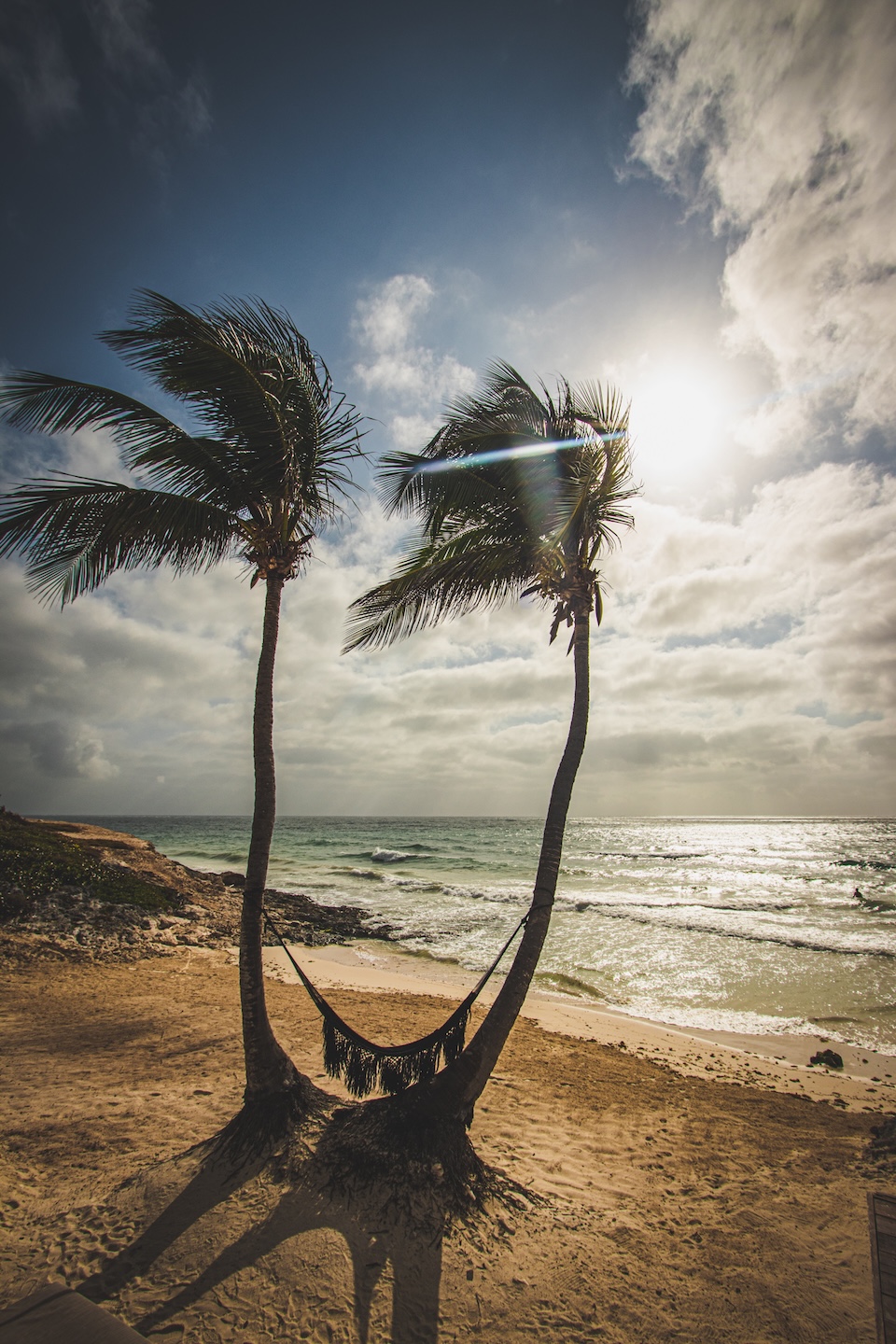
Where to best watch the sunrise?
- Your hotel beach (if you’re staying in Zona Hotelera)
- Playa Paraiso – public, easily accessible
- By the ruins – but you have to wait until opening at 8 AM
Practical tips:
- Sunrise in Tulum is between 5:45 and 7 AM (depending on month)
- Bring something warm – it can be cool at 6 AM
- Apply sunscreen – UV rays are strong even at that hour
My Honest Take:
This was the most beautiful part of every day in Tulum. Free. Real. Spiritual. Absolutely worth getting up earlier than usual.
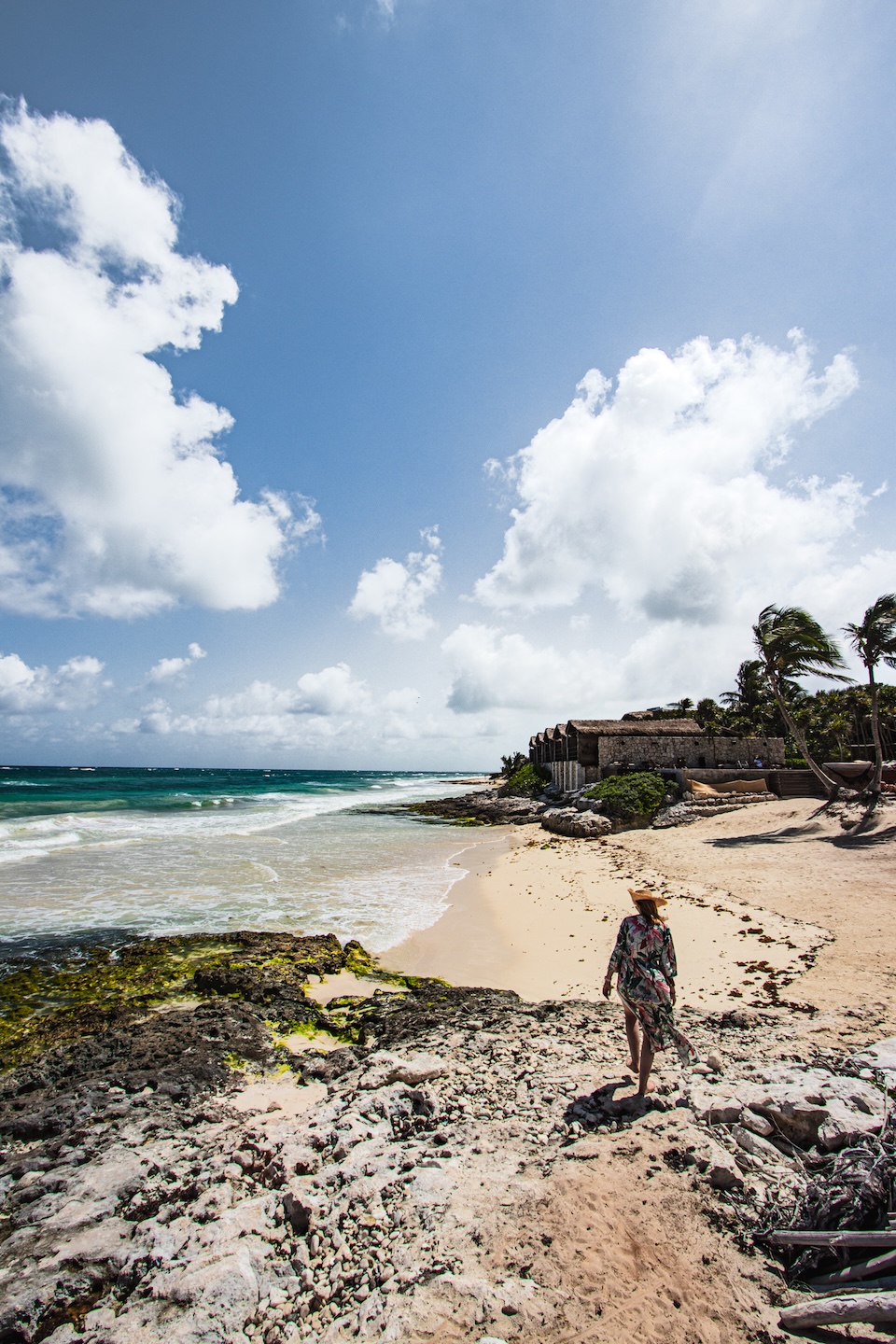
5. Beaches – Beautiful, But With an Asterisk
I have to be honest with you – beaches in Tulum are a… complicated topic.
On one hand they’re fabulously beautiful. White sand, turquoise water, palms like from a catalog. Instagram doesn’t lie – they really look like that.
On the other hand – there are a few “buts” that nobody talks about in resort ads.
Problem #1: Seaweed
For several years the Caribbean has been struggling with a plague of sargasso – brown seaweed that the ocean throws onto the shore. Depending on the season, they can completely cover the beach line and… well, effectively ruin the view.
I was lucky – I was there in April, there was little seaweed. But I saw photos from July and August… and that’s a completely different story (or rather anti-story).
When is there least? From November to April – but there’s no guarantee.

Problem #2: Public vs Private
Technically all beaches in Mexico are public. Practically? In Tulum many of them have been “appropriated” by hotels in Zona Hotelera.
They put up “guests only” signs, hire security, and access from outside can be difficult or unpleasant. As a result – the most beautiful pieces of coast are often out of reach if you’re not staying in the right place.
How I Did It:
First four nights I spent at Our Habitas – thanks to that I had access to a private, peaceful beach.
Then I moved to downtown Tulum and used public beaches. And here too you can find beautiful places – you just need to know when and where.
Best Public Beaches
Playa Paraiso – Most Famous (and Most Crowded)
This is THAT beach from all the postcards. White sand, azure water, palms, wooden platforms – classic Tulum.
I was there twice:
- At 7 AM – paradise. Quiet, empty, magical.
- At 12 PM – nightmare. Crowds, noise, vendors every step.
Practical Info:
- Free entry
- Easy access
- Beach clubs with lounge chair rental option
- Vendors can be pushy (prepare for “massage?” every 5 minutes)

Playa Pescadores – My Favorite Public Beach
Less known, more local, and calmer. Fishing boats dock at the shore – this adds authentic character. Less “Instagram”, more “real Mexico”.
Who It’s For:
For those who want to avoid crowds but still be close to the action center.
Playa Ruinas – With a View of History
Small beach right below the Mayan ruins. You can swim with a view of 13th-century structures. Pure magic.
But:
- It’s very small and gets crowded quickly
- You can only access it from the ruins area (admission ticket: 95 pesos)
My Advice:
Come in the morning, see the ruins, then go down to the beach for a quick refreshment. At noon it can be unbearable.
Practical Tips For All Beaches:
- Come early morning or late afternoon – midday is hell
- Wear mineral sunscreen – for the good of the reef and your skin
- Bring cash – for lounge chairs, drinks, and beach clubs
- Pack your own towel – not everywhere can you rent one
- Stay hydrated – the sun in Tulum is merciless
My Honest Take:
Beaches in Tulum are beautiful. Really. But they can also disappoint – through crowds, commerce, and difficult access.
If you have the budget, it’s worth staying by the beach for at least 2-3 nights. If not – hunt for public beaches at dawn. That’s when Tulum reveals its magic.
Planning a longer trip? Tulum fits perfectly into a bigger Yucatan journey. Check out my detailed 3-week Yucatan travel itinerary – Tulum is one of the gems on this route.
6. Sian Ka’an Biosphere Reserve – For True Nature Lovers
Sian Ka’an is one of those places most tourists haven’t heard of. And that’s exactly what makes it so special.
The reserve is located about 1.5 hours drive south of Tulum. It’s a huge area of protected nature – full of jungle, mangrove forests, lagoons, and coral reefs.
I didn’t make it there (ran out of time), but everyone who’s been says it’s one of the most beautiful and wildest places in the Yucatan. For many – the absolute highlight of their Tulum stay.
What Can You See:
- Dolphins (if luck favors you)
- Flamingos
- Crocodiles
- Manatees (sea cows)
- And above all: wild, untouched nature
What You Need to Know:
- You need an SUV or organized tour
- Most popular entrance: from Punta Allen side
- Admission: 104 pesos
- Boat rental (for 6 people): around 3500 pesos
- It’s a full day expedition – best to leave early morning
Who It’s For:
For people in love with nature who want to see the wild side of the Yucatan, have a day of time, and desire for real adventure.
Who It’s Not For:
If you dream of a drink with an umbrella and a lounge chair on the beach – this isn’t the vibe. There are no luxuries here. It’s wild, raw, natural.
My Advice:
If you only have 2-3 days in Tulum – you can skip it. But if you’re staying a week or longer – definitely worth it.

7. Art in Tulum – Between Nature and Design
Tulum isn’t just beaches and smoothie bowls. It’s also a place where artists, architects, and spiritual nomads meet. Design permeates nature here, and nature – design.
SFER IK – Museum That Looks Like a Spaceship
I didn’t go inside (400 pesos for a small museum is a lot for me), but I saw the building from outside – and it makes an impression.
Organic architecture looks like it grew from the jungle. Wood woven into impossible shapes, winding walkways, textures from another world. Totally Instagrammable.
Practical Info:
- Open: 10 AM – 7 PM
- Admission: 400 pesos (~$20 USD)
- Inside: contemporary art, workshops, installations
- Location: in the luxury Azulik district
Is It Worth It?
If you love contemporary art, architecture, and immersive experiences – yes. If not – you’ll find better ways to spend 400 pesos in Tulum.
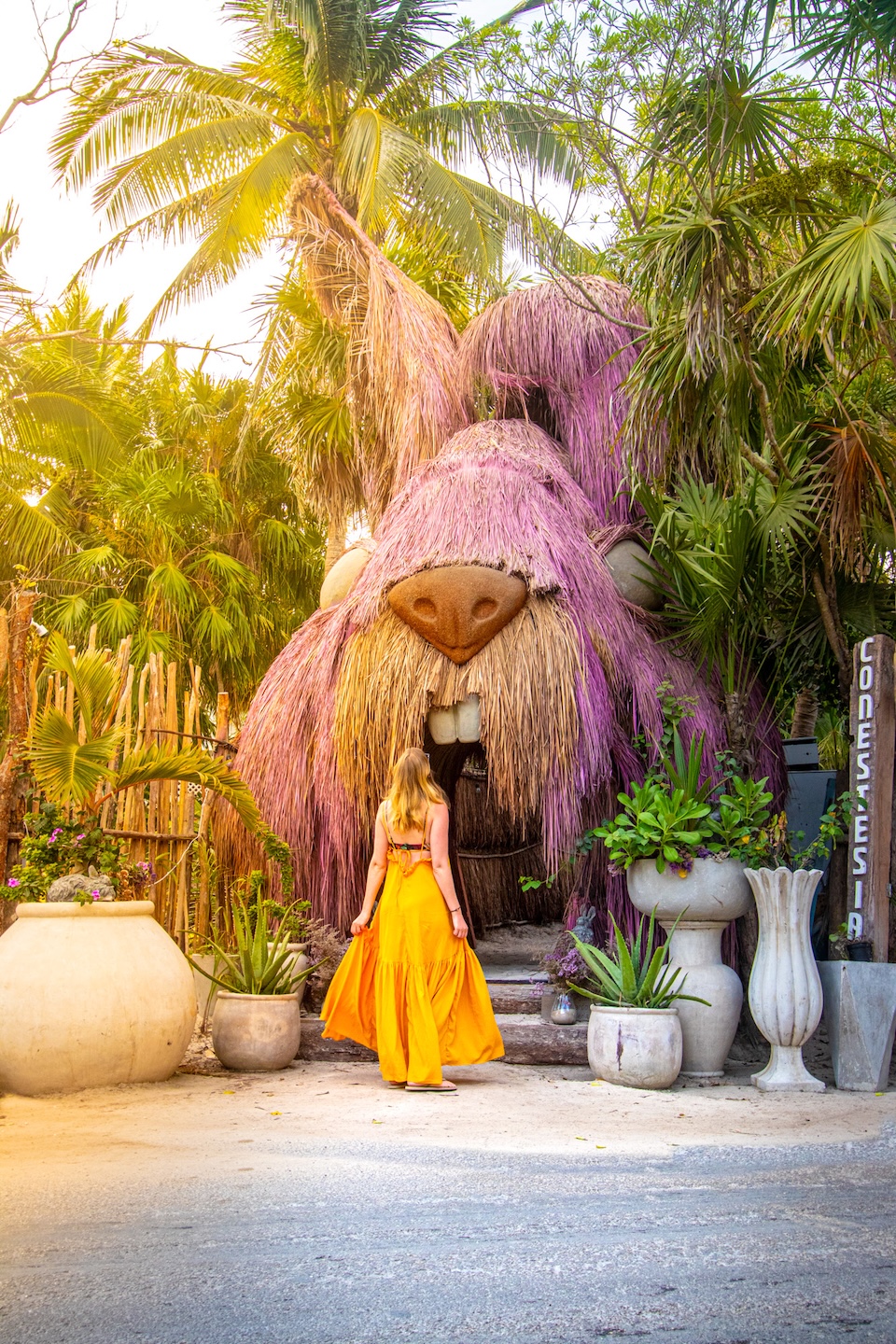
“Ven a la Luz” – Wooden Goddess of Nature
This is one of those places where you go “because Instagram” – and indeed, it’s hard not to be enchanted.
It’s a huge wooden sculpture of a woman with an open chest, from which vegetation “grows”. Project by Daniel Popper. Symbolizes the unity of man with nature.
The sculpture stands in front of the Ahau Tulum hotel and is one of the most photographed spots in the city.
Practical Info:
- Entry: free (though the hotel tries to discourage – ignore it)
- Best to come early morning (7 AM – 8 AM), before crowds appear
- Parking available at the hotel
My Advice:
Worth stopping for 15 minutes and taking a photo. Not worth making a special trip if you’re far away.

8. Tulum Pueblo – Where Real Mexico Begins
Tulum Pueblo is the city center – a place where daily life unfolds, not just tourist fairy tales.
This is where people live. Here they shop, eat tacos on a plastic chair, and live… normally.
I spent four nights here at Hotel Tiki Tiki and absolutely loved this part of Tulum.
What You Won’t Find Here:
- Designer hotels for $200 a night
- Restaurants serving acai bowls for 200 pesos
- Instagram aesthetic at every turn
What You’ll Find Instead:
- Real tacos for 25 pesos (see point 9!)
- Local markets and street life
- Mexicans living their own rhythm
- Authentic atmosphere, without tourist veneer

What I Liked:
- Colorful buildings
- Loud music from bars in the evenings
- Food smells on every corner
- Feeling that I’m in REAL Mexico
Practical Tips:
- Accommodation in Pueblo is 2-3 times cheaper than in the hotel zone by the beach
- You’ll get to the beach in 10-15 minutes by car or bike
- More local life, fewer tourists
- Better WiFi, air conditioning, and infrastructure
My Honest Take:
If you have a limited budget or plan to stay in Tulum longer than a few days – choose Pueblo. Spend saved money on experiences, not accommodation.
Where exactly to eat? Check out point 9 – I share my favorite places where I ate some of the best tacos of my life.
How do you want to explore Yucatan?
🗺️ Complete itinerary → 3-Week Yucatan Travel Itinerary – Tulum is just one point
🍽️ Flavors of Mexico → 10 Yucatan Dishes You Must Try – guide to local cuisine
🏖️ Paradise island → Isla Holbox Guide – small island without cars
🏨 Where to stay → My Experience from 2 Tulum Hotels – honest reviews without BS
What attracts you most about Tulum?
9. Local Food – Where Tulum Really Tastes Good
Forget all the designer restaurants with acai bowls for 200 pesos. Real Tulum tastes completely different – and infinitely better.
For eight days I ate everywhere – from luxury restaurants at Our Habitas to street tacos for 25 pesos. And you know what? The cheap ones often beat the “fine dining” ones.
Taqueria Honorio – Best Cochinita Pibil of My Life
This was my biggest culinary discovery. An unassuming joint in the city center, where at 11:00 AM there’s already a line.
Cochinita pibil is marinated pork, slowly roasted in banana leaves.
Meat so tender it falls apart by itself. Served in a warm corn tortilla, with onion marinated in orange juice and habanero.
I ate there three times. Would have been more often, but – of course – closed on Tuesdays, exactly when I wanted to go back.
Practical Info:
- Open: 6:30 AM – 3 PM (closed Tuesdays)
- Price: around 40 pesos per taco
- Come before 1 PM – after this hour the best pieces run out
- Cash only
My Advice:
Order a taco with cochinita pibil + lemonade. Nothing else needed. This is perfection.
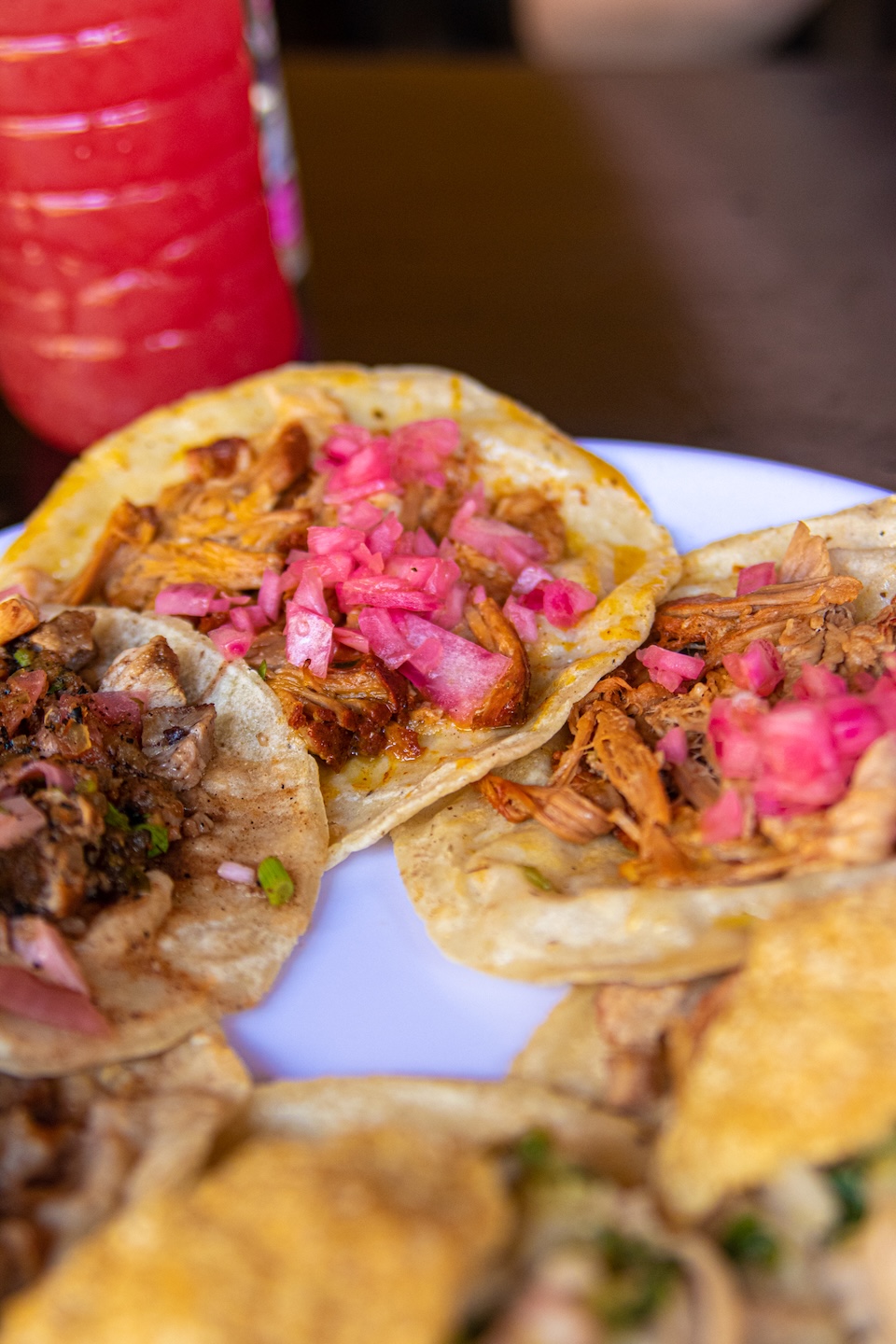
Antojitos La Chiapaneca – Where Locals Eat
I discovered this place by accident. I was riding my bike, saw a crowd of locals, and thought: “This must be good“. And I was right.
Small, modest joint where they serve everything: tacos, quesadillas, tortas, sopes. Nothing fancy, but everything fresh and really tasty.
What I Ordered:
- Tacos al pastor (pork with pineapple) – my favorite
- Tacos de pollo (chicken)
- Agua de horchata (sweet rice drink with cinnamon)
Practical Info:
- Open: 10 AM – 11 PM (closed Mondays)
- Price: 25-40 pesos per taco
- Most popular in evenings (5 PM – 8 PM)
What Surprised Me:
Zero tourists. Only locals. And that’s always a good sign.

Burrito Amor – Cult Place (And Rightly So)
I heard about Burrito Amor from everyone: “You have to go there”, “Best burrito in Tulum”, “Don’t miss it”. I was skeptical… But I have to admit – it was worth it.
What I Ordered:
Burrito with chicken, black beans, rice, and guacamole. Huge. I barely managed half.
Practical Info:
- Open: 8 AM – 10 PM (daily)
- Price: 140-180 pesos per burrito
- Popular at all times
- Takeout option available
My Honest Take:
Very good, but more expensive than local joints. Worth trying once, but not necessarily coming back daily.

Raw Love – For Days When You Feel Like Something “Healthy”
After three days of tacos I felt like something lighter. Raw Love turned out to be the perfect reset.
I ordered an acai bowl: frozen acai berries, bananas, granola, fruit, peanut butter. Instagrammable and delicious.
The menu also has smoothies, avocado toast, vegan burgers, and gluten-free options.
Practical Info:
- Open: 8 AM – 8 PM (daily)
- Price: 150-200 pesos per bowl
- WiFi works (good place to work with laptop)
My Honest Take:
Tasty, but these are already tourist prices. If you’re craving acai – go. If you want cheap and local – return to Honorio.
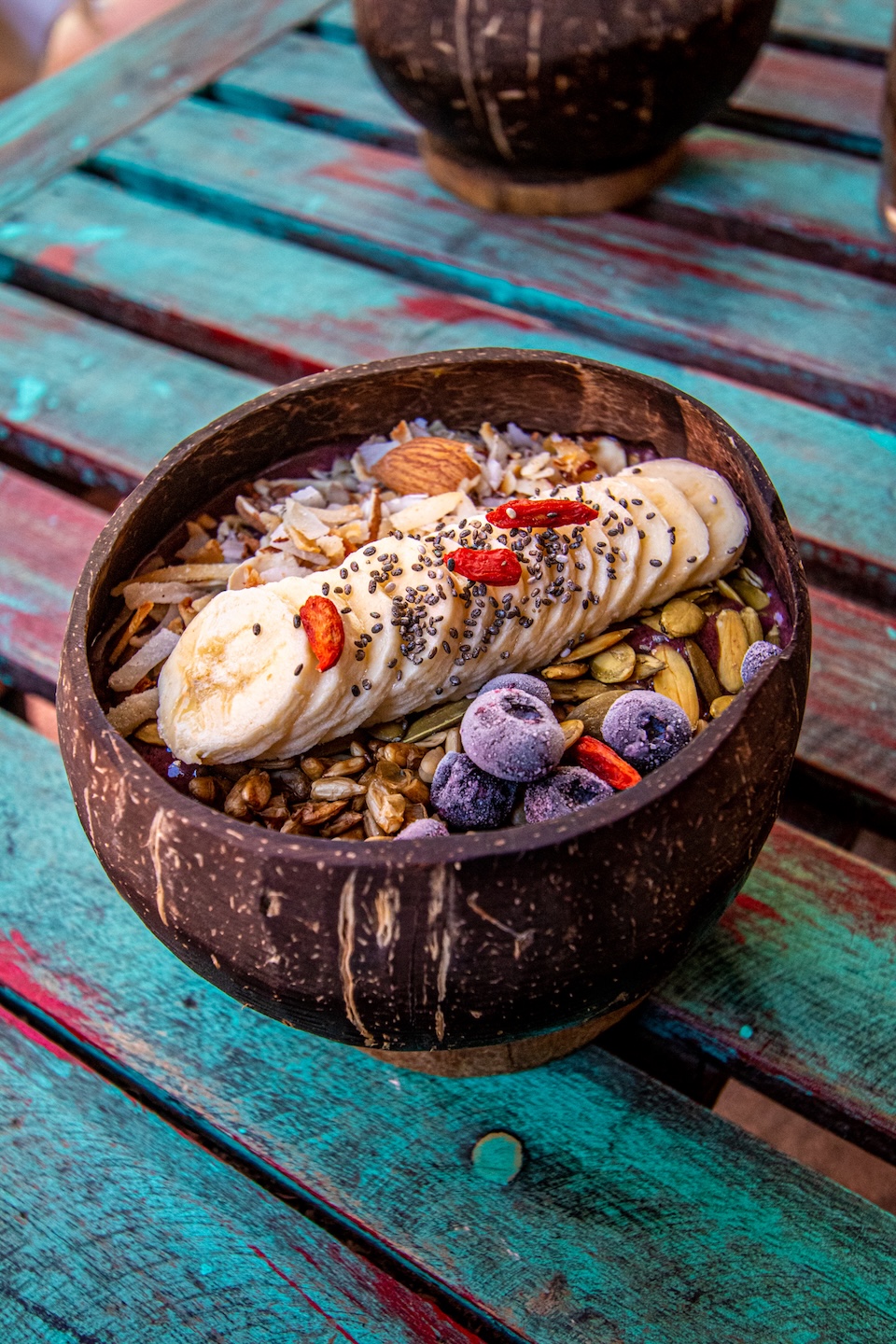
My Strategy:
- Breakfasts: Hotel Tiki Tiki (included in price) or Raw Love (when I felt like something “luxurious”).
- Lunches: Local taquerias – mainly Honorio and Chiapaneca (cost: 40-80 pesos).
- Dinners: Sometimes fine dining at Our Habitas (~600 pesos), sometimes Burrito Amor (~150 pesos), sometimes again… tacos (25 pesos).
Average daily food cost:
- When I ate local: ~$8-10 USD
- When I went to restaurants: ~$20-25 USD
Don’t be afraid of street joints. The best food in Tulum you’ll find where locals eat – not those setting up their phone on a tripod before they taste a bite.
Want to know what else is worth eating in Tulum? Check out my guide to 10 dishes you must try in Yucatan – cochinita pibil is just the beginning!
10. Sleeping in a Tent in the Jungle – Glamping You Won’t Forget
When people hear “tents in Tulum”, they usually think of cheap, simple places for backpackers. Our Habitas is a completely different story.
This is glamping in the most luxurious version – where “tent” has air conditioning, a king-size bed, full bathroom, and outdoor shower under the sky.
I spent four nights there. And it was one of the most beautiful stays of my life.
Why Was It So Special?
Three moments that stayed with me for long:
- Shower under the stars at midnight – part of the bathroom was outside. I took a shower, looking at a sky full of stars and listening to the ocean. Sounds like a movie scene? That’s exactly how I felt.
- Cacao smoothie every morning – I walked barefoot on sand to the beach restaurant and ordered the same smoothie every day. Sometimes two. This little routine had something magical about it.
- “Tribe” bracelet – at check-in I got a rope bracelet with “Welcome to the tribe” written on it. And for the next four days I really felt part of something more than just hotel reality.
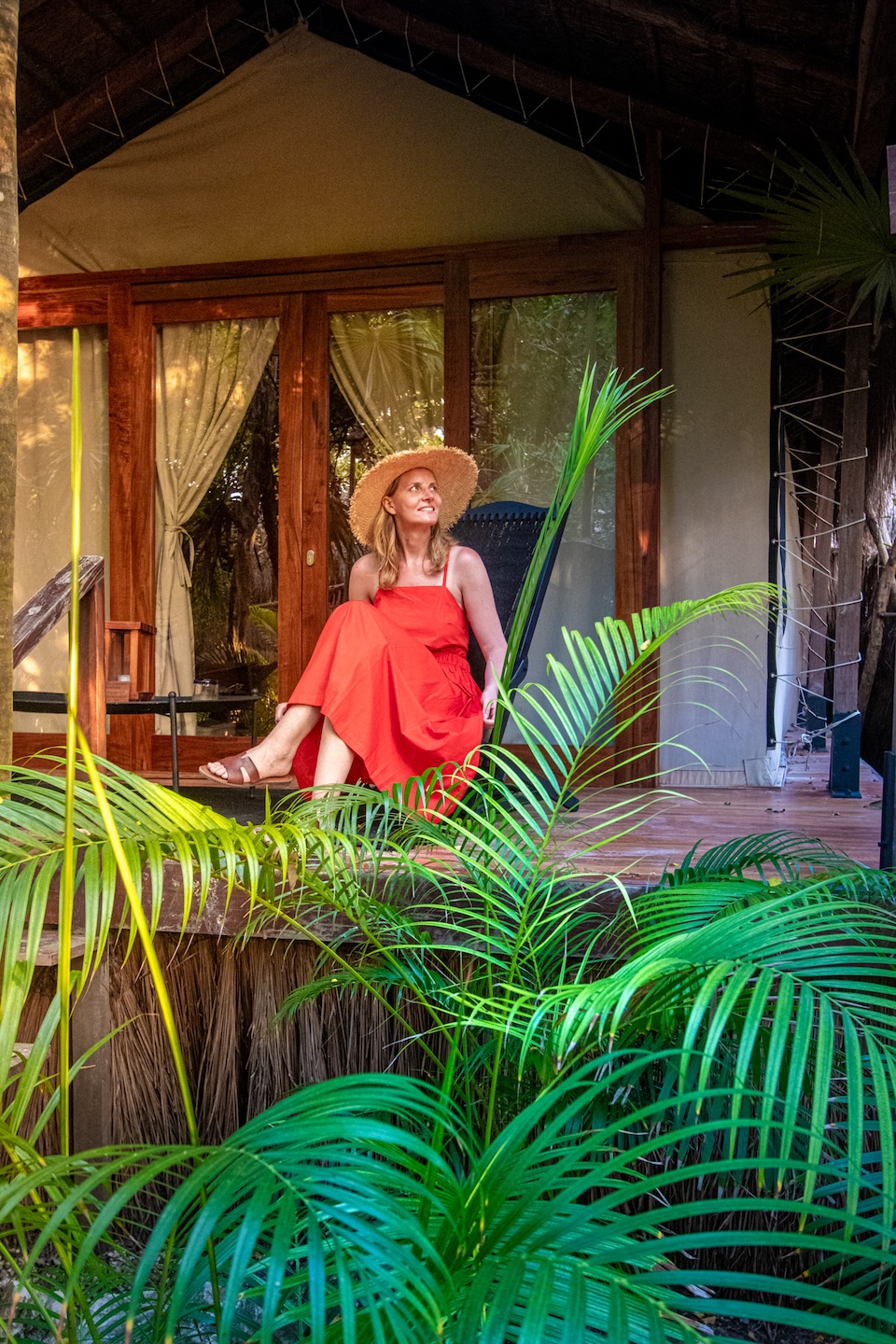
Honest Facts:
- Price: around $280 USD per night
- Who it’s for: for couples, solo travelers, and everyone who wants to feel “Tulum magic”.
- Who it’s not for: people with limited budget, needing stable WiFi, and families traveling with children (hotel only for guests 18+).
Is It Worth It?
It depends. If I had a week – I’d spend 2 nights here and the rest in the center. But if I only had 3 days and wanted to really feel Tulum – I’d choose all 3 right here.
This isn’t just accommodation. It’s an experience. A spiritual reset. A moment when you understand why so many people fall in love with Tulum.
A full, detailed review of Our Habitas (along with comparison to the downtown hotel, all restaurant prices, WiFi, and answer to “is it really worth it?”) you’ll find in my Tulum hotels guide – there I share ALL the details from 8 nights in two very different places.
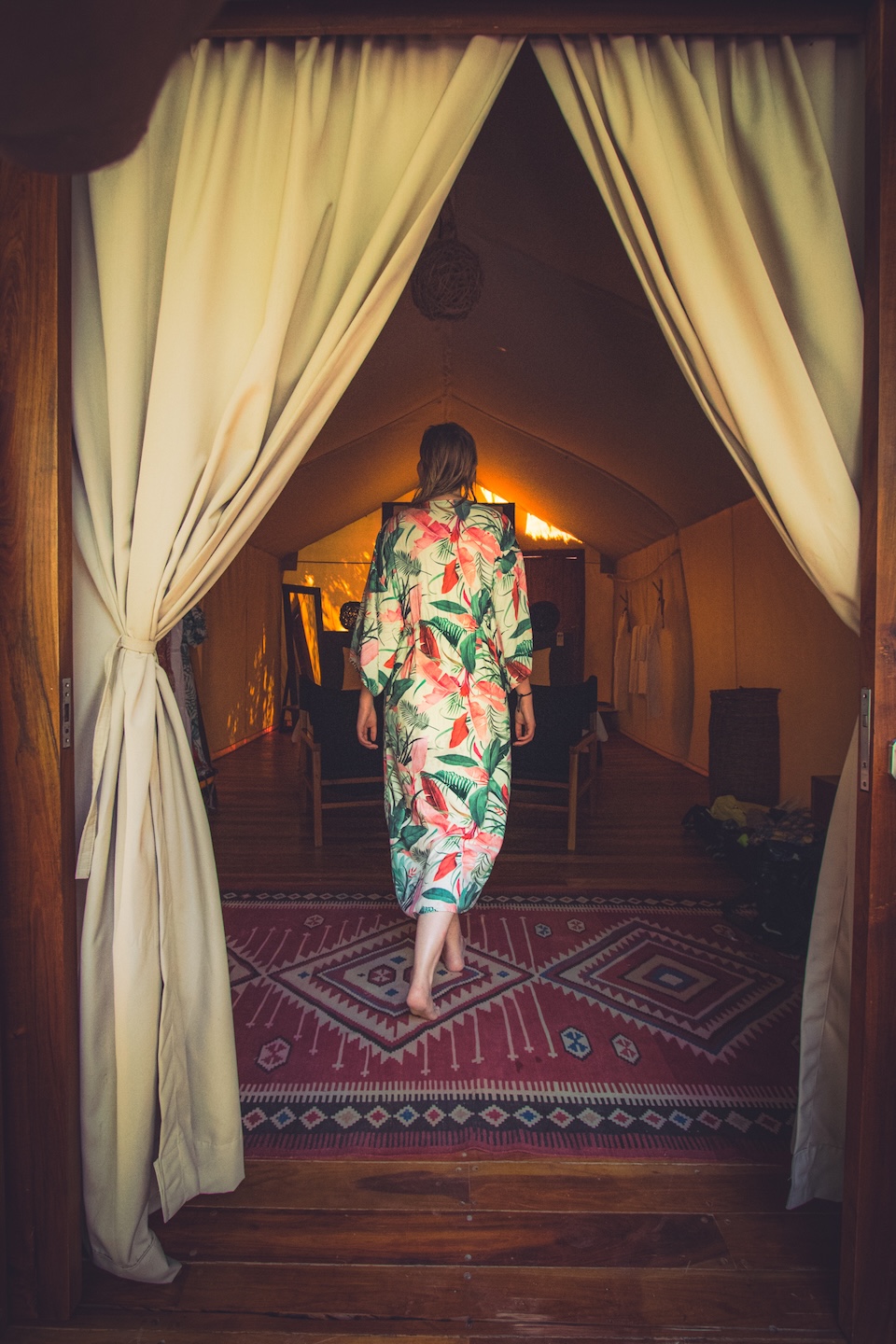
Practical Tips – Everything You Need to Know
When to Go to Tulum?
Best time: November – April
- Dry, sunny, pleasant
- Less seaweed on beaches
- More tourists (and higher prices)
Good time: May, October
- Transition months
- Sporadic rains
- Fewer crowds
Avoid: June – September
- Hot, humid, rainy
- Lots of seaweed
- Hurricane season (especially September)
I was there in April – perfect balance. Warm but not hellishly so, dry, clean beaches, and everything still before summer peak season.piekielnie, sucho, czyste plaże, a wszystko jeszcze przed letnim szczytem sezonu.
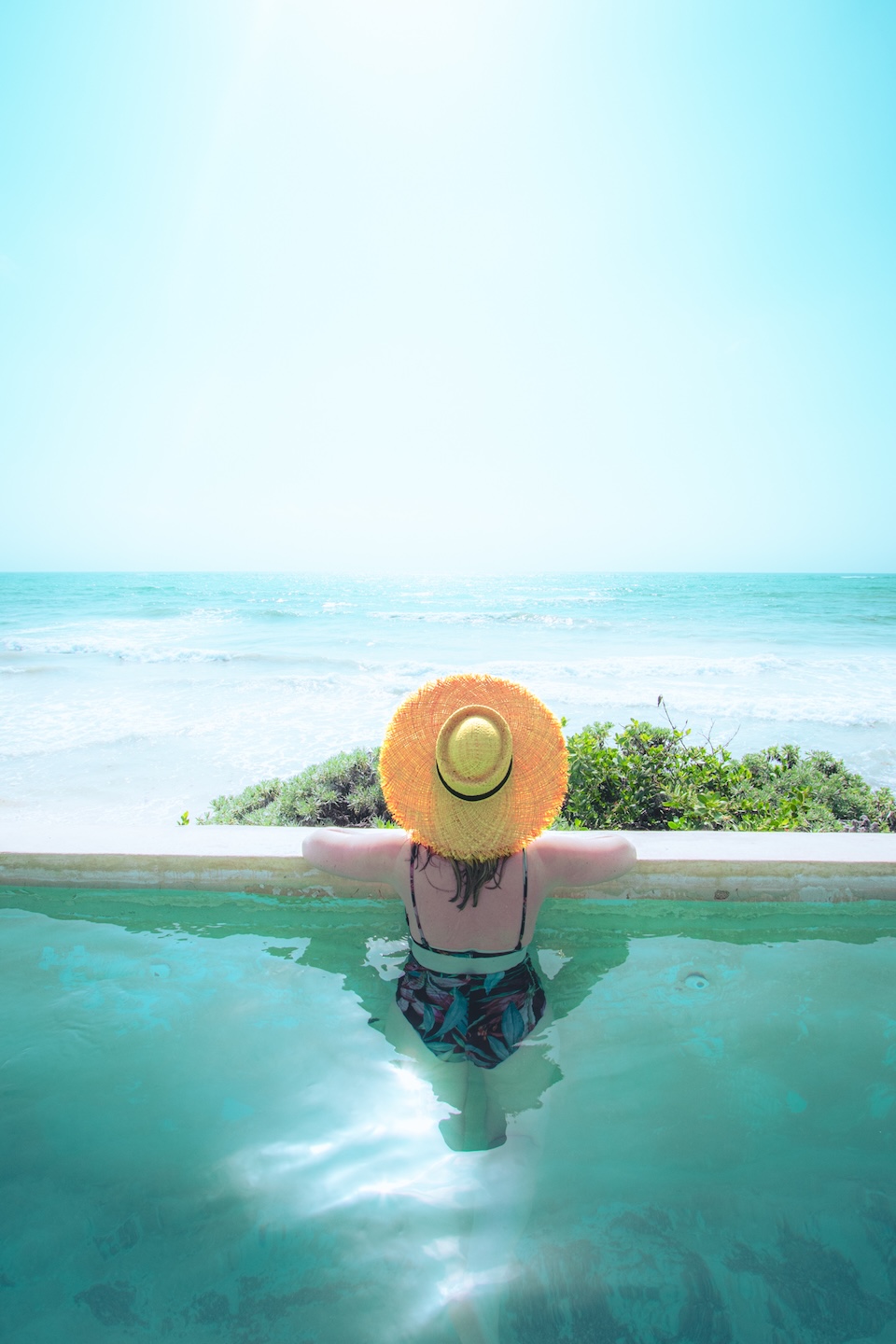
How to Get to Tulum?
From the US to Cancún:
Option 1: Direct flights
- From most major cities (NYC, LA, Miami, Chicago, Dallas, Houston)
- 2-5 hours flight (depending on your departure city)
- $200-500 round trip (deals can go lower!)
- Year-round availability
Option 2: Connecting flights (budget option)
- Through major hubs
- Can save $100-200
- Adds 2-4 hours travel time
- Best for flexibility and deals
From Cancún to Tulum:
ADO Bus:
- Most budget option
- ~1.5-2 hours
- ~$20 USD
- Comfortable, air-conditioned, punctual
Car rental:
- From ~$25/day
- Freedom of movement
- Perfect for trips – I rented and don’t regret it
Private transfer:
- ~$75-100 USD
- Comfortable if you’re tired after the flight
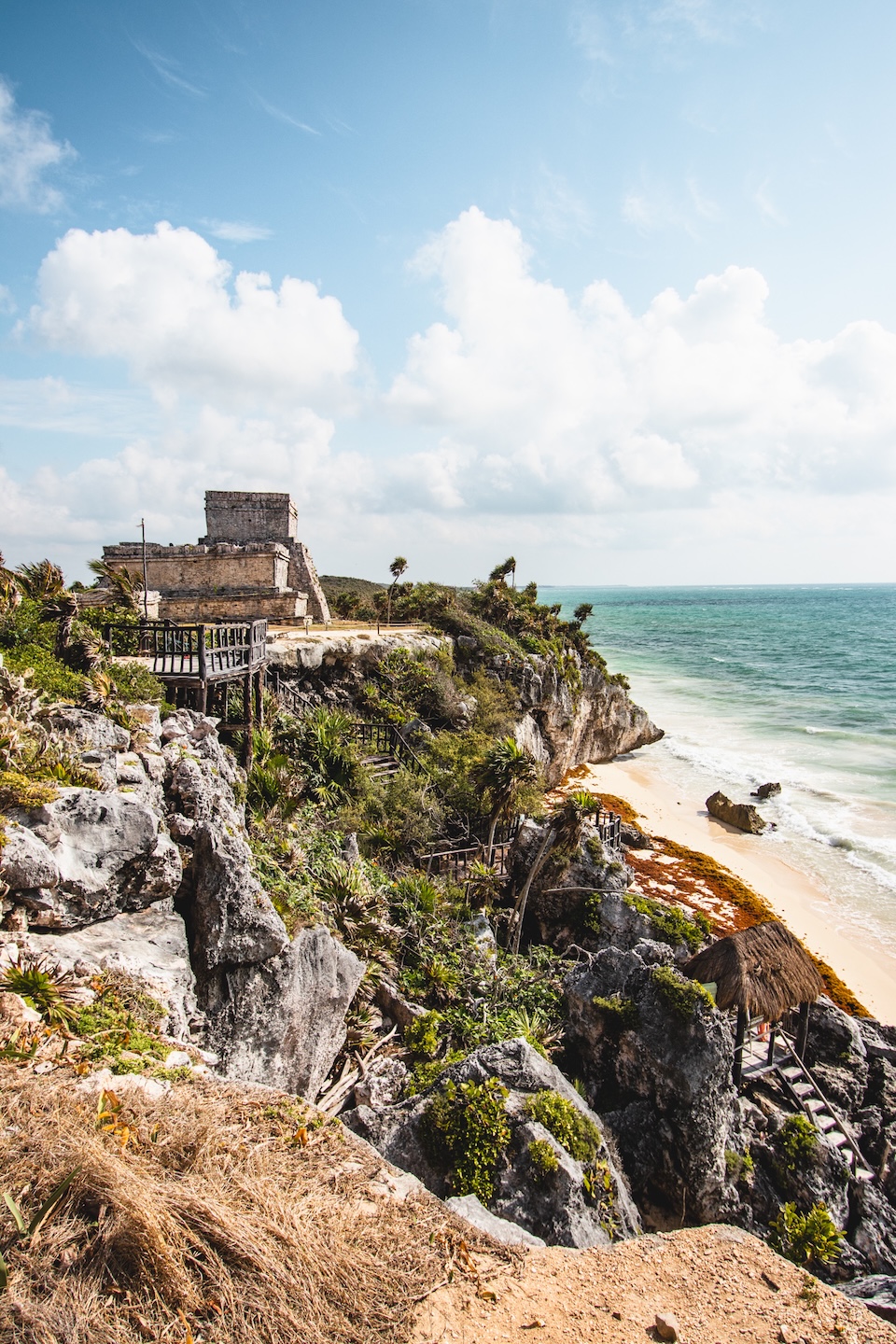
How to Get Around Tulum?
Bike – My favorite way
- Eco-friendly, cheap, healthy
- $5-10 per day
- Perfect in the center and for short distances
- Don’t recommend for Zona Hotelera – sand!
Colectivo (local minibuses)
- Super cheap (~$1-2)
- Run between center and beach
- Local experience
Taxi/Meleks
- Comfortable but expensive
- Center to beach: ~$12-15
- Always agree on price before!
Scooter
- ~$20-30 per day
- Faster than bike
- Careful on sandy roads
Car
- Best choice if you want to explore cenotes and ruins
- Parking often free
- Gas expensive (~$1.30/liter)
My Strategy: Bike in center, car for trips to cenotes and ruins., samochód na wycieczki do cenotes i ruin.

Where to Sleep in Tulum?
This is a topic for a separate article (and I have one!), but briefly:
Zona Hotelera (beach):
- Expensive (from $75/night up)
- Directly on beach
- Stylish, boho hotels
- Often no AC and weak WiFi
- I stayed at Our Habitas ($280/night) – beautiful but very expensive
Tulum Pueblo (center):
- Cheaper (from $40/night)
- Good WiFi, AC
- Close to restaurants and shops
- 10-15 min to beach
- I stayed at Hotel Tiki Tiki ($100/night) – great quality-price ratio
My Advice: If you have budget and want the experience – 2-3 nights on beach. Then move to center and save.
Want detailed reviews? Check my Tulum hotels guide – I share honest experiences from both places.
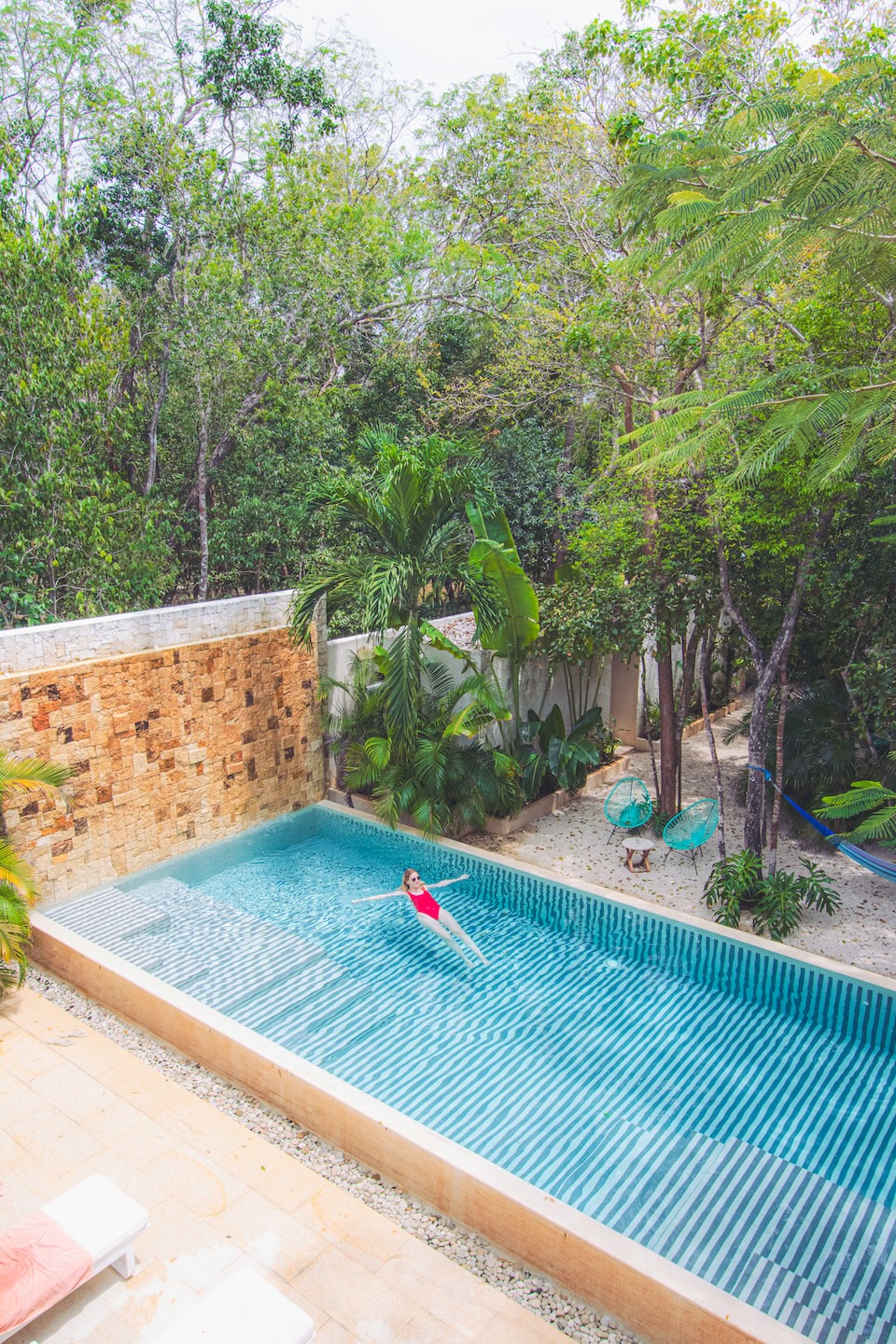
Budget – How Much Does Tulum Really Cost?
Zona Hotelera:
- Accommodation: $75-300
- Meal in restaurant: $20-80/person
- Drink: $10-30
- Beach trip: $0 (you’re already there!)
Tulum Pueblo:
- Accommodation: $40-100
- Meal in restaurant: $10-20/person
- Street food: $2-6
- Bar drink: $4-10
- Transport to beach: $6-12 (round trip)
Attractions:
- Tulum Ruins: $5
- Cenote: $15-25
- Car rental: $25/day
- Gas: ~$20/day of driving
My Real Budget (8 days):
- Accommodation: $640 (4 nights luxury + 4 center)
- Food: ~$250
- Transport: ~$200 (car rental + gas)
- Attractions: ~$125
- Total: ~$1,200 USD
Can It Be Cheaper?
Yes – stay only in center, eat street food, skip expensive alcohol. Can go down to ~$500/person for a week.
Can It Be More Expensive?
Oh yes. Accommodation only in luxury places, restaurants every day, beach drinks – you can spend $2,000 for a week without problem.
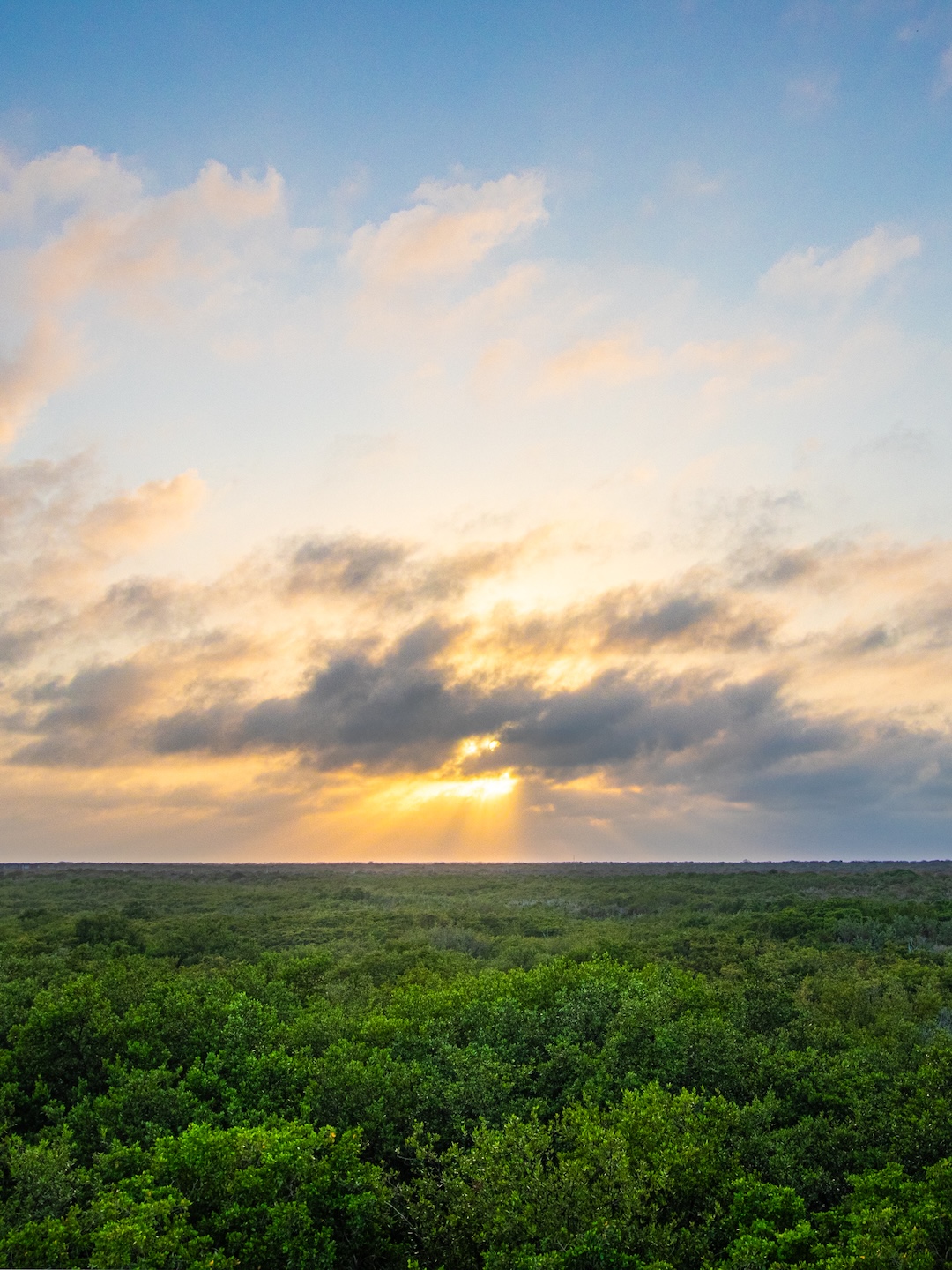
Safety
Tulum is generally safe, but:
Watch out for:
- Pickpockets in crowds
- Night walks in remote places
- Leaving things unattended on beach
My rule: Use common sense. In 8 days I didn’t have any dangerous situations. But common sense always valuable.
Tap water: Don’t drink! Buy bottled.
Sun: Don’t underestimate. Sunscreen, hat, water. The sun here really burns.

Travel Budget Calculator
Get your free Travel Budget Calculator now and plan your trip without the stress of overspending!
Best Things to Do in Tulum – My Honest Thoughts
After eight days in Tulum I know one thing – this place is as beautiful as they say, but also as complicated.
There are moments when you stand by the Mayan ruins at sunrise and think: “This is paradise on earth”.
And there are moments when you pay 200 pesos for guacamole and think: “This is tourist absurdity”.
But the truth about Tulum lies somewhere in between. It’s a place where the magic of ancient civilization meets modern tourism. Where authentic Mexico mixes with Instagram aesthetic.
Is it worth going? Yes, absolutely. But with realistic expectations.
How long to stay? 4-7 days is ideal. Shorter – you won’t have time to feel the vibe. Longer – it might get repetitive.
My final advice: Show up everywhere early. Stay in the center if you have a limited budget. Rent a car. Eat cochinita pibil. Wake up for sunrise. And give yourself space to just… be.
Because the most beautiful moments in Tulum aren’t on any “top 10” lists. They’re those moments when you sit in a cenote and feel silence.
When you eat tacos on the street and talk with a local vendor. When you look at the sky at dawn and feel gratitude that you’re here.
This is real Tulum. And it’s waiting for you.
Ready to discover more of Yucatan?
- 3-Week Yucatan Travel Itinerary – complete route with Tulum, Holbox, Valladolid
- My Experience from 2 Tulum Hotels – honest reviews of Our Habitas and Hotel Tiki Tiki
- Isla Holbox Travel Guide – small island without cars and the most beautiful sunsets
- 10 Yucatan Dishes – what you must try in Mexico
Leave a comment – I’d love to chat about Tulum!
And if this honest guide helped you, send it to someone planning to go there. Let them go with open eyes and heart.

